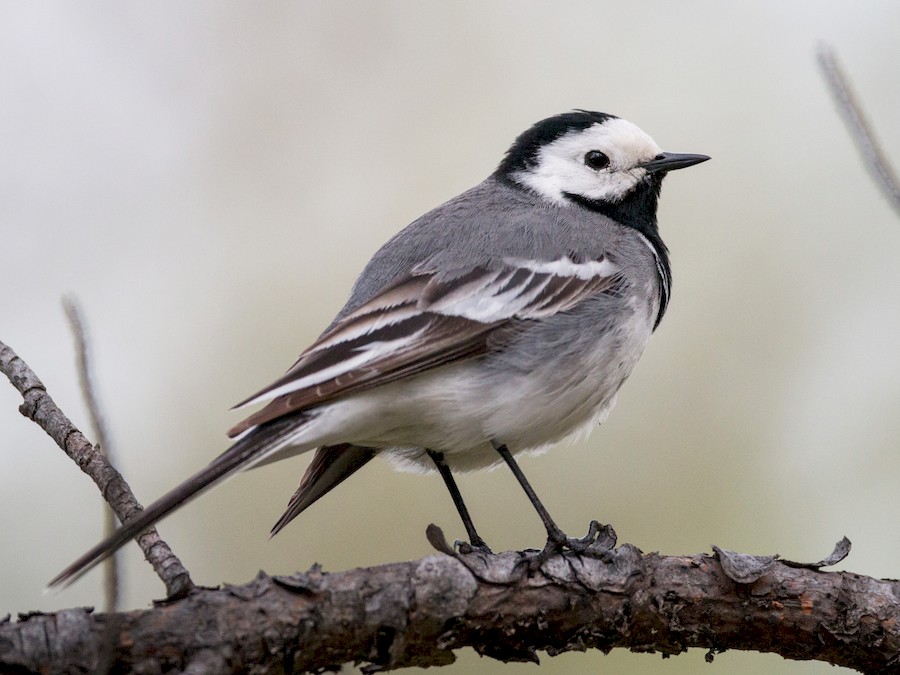
White Wagtail
Motacilla alba
Order:
Family:
Size:
16.5-18 cm
Weight:
M 20-24.6 g
Taxonomy:
(Sykes, 1832)
Short Description:
The white wagtail (Motacilla alba) is a small passerine bird in the family Motacillidae, which also includes pipits and longclaws. The species breeds in much of Europe and Asia and parts of North Africa. It has a toehold in Alaska as a scarce breeder. It is resident in the mildest parts of its range, but otherwise migrates to Africa. In Ireland and Great Britain, the darker subspecies, the pied wagtail (M. a. yarrellii) predominates. The white wagtail is an insectivorous bird of open country, often near habitation and water. It prefers bare areas for feeding, where it can see and pursue its prey. In urban areas it has adapted to foraging on paved areas such as car parks. It nests in crevices in stone walls and similar natural and man-made structures. The white wagtail is the national bird of Latvia. The white wagtail was one of the many species originally described by Linnaeus in his 18th-century work, Systema Naturae, and it still bears its original name of Motacilla alba. The Latin genus name originally meant "little mover", but certain medieval writers thought it meant "wag-tail", giving rise to a new Latin word cilla for "tail". The specific epithet alba is Latin for "white". The white wagtail is a slender bird, 16.5 to 19 cm (6.5 to 7.5 in) in length (East Asian subspecies are longer, measuring up to 21 cm (8.3 in)), with the characteristic long, constantly wagging tail of its genus. Its average weight is 25 g (0.88 oz) and the maximum lifespan in the wild is about 12 years. The nominate subspecies (Motacilla alba alba) is basically grey above and white below, with a white face, black cap and black throat. There are a number of other subspecies, some of which may have arisen because of partial geographical isolation, such as the resident British form, the pied wagtail M. a. yarrellii, which now also breeds in adjacent areas of the neighbouring European mainland. The pied wagtail, named for naturalist William Yarrell, exchanges the grey colour of the nominate form with black (or very dark grey in females), but is otherwise identical in its behaviour. Other subspecies, the validity of some of which is questionable, differ in the colour of the wings, back, and head, or other features. Some races show sexual dimorphism during the breeding season. As many as six subspecies may be present in the wintering ground in India or Southeast Asia and here they can be difficult to distinguish. Phylogenetic studies using mtDNA suggest that some morphological features have evolved more than once, including the back and chin colour. Breeding M. a. yarrellii look much like the nominate race except for the black back, and M. a. alboides of the Himalayas differs from the Central Asian M. a. personata only by its black back. M. a. personata has been recorded breeding in the Siddar Valley of Kashmir of the Western Himalayas. It has also been noted that both back and chin change colour during the pre-basic moult; all black-throated subspecies develop white chins and throats in winter and some black-backed birds are grey-backed in winter. The call of the white wagtail is a sharp chisick, slightly softer than the version given by the pied wagtail. The song is a pleasant twittering, more regular in white than pied, but with little territorial significance, since the male uses a series of contact calls to attract the female. White Wagtail is a very widespread winter visitor throughout the indus plains and less common throughout Baluchistan. White Wagtail breeds in gravelly streams throughout northern areas and in the Kurram Valley, wintering in northern Punjab and KPK foothills. Breeds sparingly from northern Chitral to Baltistan, with some wintering in the northern plains of Punjab and KPK.
Far far away, behind the word mountains, far from the countries Vokalia and Consonantia, there live the blind texts. Separated they live in Bookmarksgrove right at the coast
Lahore,Bahawalpur,Rahim Yar Khan,Kasur,Bahawalnagar,Bhakkar,Chakwal,Gujranwala,Gujrat,Jhang,Khushab,Mandi Bahauddin,Mianwali,Narowal,Nankana Sahib,Okara,Rajanpur,Sargodha,Sialkot,Toba Tek Singh,Dadu,Karachi Central,Larkana,Karachi East,Karachi South
White Wagtails are highly active birds, constantly moving about in search of food. They feed primarily on insects and small invertebrates which they catch by darting and pecking at the ground or water surface. They are often seen perched on rocks, fences, or wires, and are known for their distinctive habit of wagging their tails up and down. White Wagtails are also migratory birds, with some populations moving to warmer regions during winter months. They are generally sociable and may be observed in small flocks, particularly during migration.
Far far away, behind the word mountains, far from the countries Vokalia and Consonantia, there live the blind texts. Separated they live in Bookmarksgrove right at the coast
About Photographer : Hello World
Facebook
Twitter
Instagram
Flicker
LinkedIn

